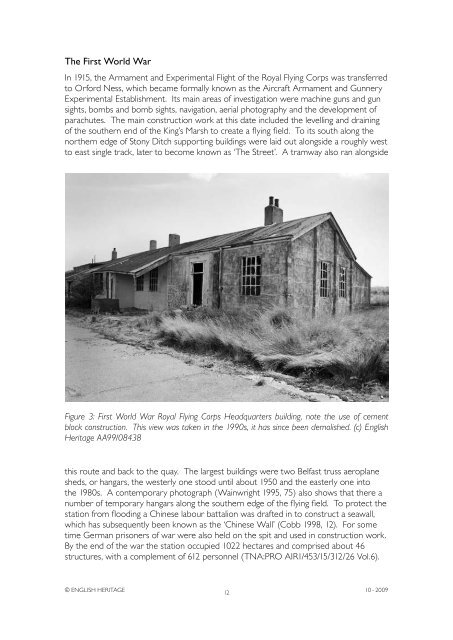Atomic Weapons Research Establishment. Orford ... - English Heritage
Atomic Weapons Research Establishment. Orford ... - English Heritage
Atomic Weapons Research Establishment. Orford ... - English Heritage
Create successful ePaper yourself
Turn your PDF publications into a flip-book with our unique Google optimized e-Paper software.
The First World War<br />
In 1915, the Armament and Experimental Flight of the Royal Flying Corps was transferred<br />
to <strong>Orford</strong> Ness, which became formally known as the Aircraft Armament and Gunnery<br />
Experimental <strong>Establishment</strong>. Its main areas of investigation were machine guns and gun<br />
sights, bombs and bomb sights, navigation, aerial photography and the development of<br />
parachutes. The main construction work at this date included the levelling and draining<br />
of the southern end of the King’s Marsh to create a flying field. To its south along the<br />
northern edge of Stony Ditch supporting buildings were laid out alongside a roughly west<br />
to east single track, later to become known as ‘The Street’. A tramway also ran alongside<br />
Figure 3: First World War Royal Flying Corps Headquarters building, note the use of cement<br />
block construction. This view was taken in the 1990s, it has since been demolished. (c) <strong>English</strong><br />
<strong>Heritage</strong> AA99/08438<br />
this route and back to the quay. The largest buildings were two Belfast truss aeroplane<br />
sheds, or hangars, the westerly one stood until about 1950 and the easterly one into<br />
the 1980s. A contemporary photograph (Wainwright 1995, 75) also shows that there a<br />
number of temporary hangars along the southern edge of the flying field. To protect the<br />
station from flooding a Chinese labour battalion was drafted in to construct a seawall,<br />
which has subsequently been known as the ‘Chinese Wall’ (Cobb 1998, 12). For some<br />
time German prisoners of war were also held on the spit and used in construction work.<br />
By the end of the war the station occupied 1022 hectares and comprised about 46<br />
structures, with a complement of 612 personnel (TNA:PRO AIR1/453/15/312/26 Vol.6).<br />
© ENGLISH HERITAGE<br />
12<br />
10 - 2009

















